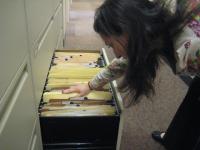Over the past few weeks, my new co-surveyor Faith Charlton and I have been surveying some collections here at HSP in order to get Faith up to speed with the HCI-PSAR Survey Method. Our methodology is nothing revolutionary--on the contrary, it is intentionally conventional because we would like our data to be comparable to similar projects. However, over the past year we found that a few adaptations and refinements were necessary when translating the basic archival survey tool into the small repository context.
Around this time last year, Matthew Lyons wrote an excellent blog post about our basic survey procedure. We utilize the methodology and criteria created for the Philadelphia Area Consortium of Special Collections Libraries (PACSCL) Survey Initiative; their methodology was, in turn, based on the Historical Society of Pennsylvania's survey method. In short, we assign ratings on a scale of 1-5 in the following five areas: Quality of Housing, Physical Condition, Intellectual Access, Physical Access, Interest, and Documentation Quality. The criteria for assigning these numerical ratings is clearly spelled out in a ratings documentavailable on the PACSCL Survey Initiative's website.
The last two ratings, Interest and Documentation Quality, are summed to form a Research Value Rating on a scale from 2 to 10. A collection rated 7 or above is considered to be a significant resource that we expect would garner a lot of attention from current and potential users. This is probably the most noteworthy rating given, as it reflects the importance of collections to the larger research community, but it is also the most difficult rating to assign as it involves a certain degree of subjectivity.
While assigning research value ratings to collections in the HCI-PSAR project, surveyors face challenges unique to small repositories. Thus, we have interpreted and adapted several key aspects of the research value rating criteria from PACSCL’s document: (1) audience interest and resources, (2) interest in collection content v. creator, (3) general guidelines for interest scores. An explanation of each of these interpretations/adaptations is provided in sections below. Overlaying these considerations, we are careful to maintain the integrity of the 7 rating. Ratings of 7 or above should stand up to scrutiny in any repository setting.

Considering the Audience
HCI-PSAR surveyors retained an awareness that the audiences served by the small historical societies and archival repositories are not necessarily the same audiences served by archival collections at large, well-known institutions. Surveyors decided to shift their perspective away from the question, “To what extent would a typical researcher at a large institution like the Historical Society of Pennsylvania find this collection useful?” and instead ask, “To what extent would a typical researcher at this or a similar repository find this collection useful?”
Keeping in mind audience interests, surveyors considered actual and intended patrons, asked about most-used collections, and recognized the “hot topics” popular at small repositories—genealogy, property research, and local history. These concerns are in line with PACSCL’s list of factors contributing to the assignment of a research value score, especially the question, "How frequently over the past five years have researchers sought materials on topics substantially documented in a particular collection?"
HCI-PSAR surveyors also recognized audience resources and expectations. Patrons of small repositories may be unwilling to travel and appreciative of local convenience. They may not care whether or not they are using original documents and might be satisfied to use access copies. For example, many of the collections surveyed during HCI-PSAR were comprised of secondary materials or photocopies of primary materials, typically relating to local history topics. Repositories often reported these artificial collections to be their most heavily used.
In other contexts, this type of collection might receive a low research value rating as the materials are not unique and interest will largely be limited to local researchers. However, HCI-PSAR kept in mind the fact that such collections are very convenient and useful to local researchers, and collections that are frequently utilized by patrons demonstrably command a high level of interest. The collections were not assigned a score that would mirror a collection of original primary materials, but they did receive a higher score than the same type of collection at a larger repository might receive.
Interest in Content v. Creator
Another clarification surveyors made in assigning research value ratings was the distinction between interest in a collection and interest in a creator. Consider the case of a small collection of personal papers from a prominent Philadelphia socialite. It may be known from Ms. Socialite's obituary that she worked with the Women's Medical College, the Philadelphia Sesquicentennial, and various ethnic relief organizations, but let's assume Ms. Socialite is not famous enough to be intrinsically interesting. The work she did and the groups she was involved with are interesting. But say this particular collection of her papers includes some photographs, personal correspondence, and genealogy research, but nothing at all related to her work or these organizations. What should the interest rating be? After being confronted with several cases like this, HCI-PSAR surveyors decided to focus specifically on rating topics actually represented in the collection, not topics that might potentially be in the collection. The documentation quality rating, then, focuses on how well the collection topics are documented—not whether or not expected topics appear in the collection.
Rough Guidelines for Interest Rating
The interest rating explanations given in the PACSCL document are very vague ("negligible" to "very high"), so HCI-PSAR came up with informal guidelines for assigning interest value.
- Interest in collection will mainly be limited to institutional researchers.
- Collection will be of interest mainly to local historians and genealogists.
- Collection reflects a regionally significant topic, person, or organization OR collection could constitute a case study for a topic of moderate interest.
- Collection reflects a nationally significant topic, person, or organization OR collection could be useful as a case study for a topic of high interest.
- Collection documents an internationally significant topic, person, or organization, or documents many topics of high interest.
With these clarifications in place, the HCI-PSAR Survey Method is pretty fixed at this point. Over the past year of the project, we've already rated over 500 collections according to this methodology. We hope to rate about 1,000 more in the next two years!

